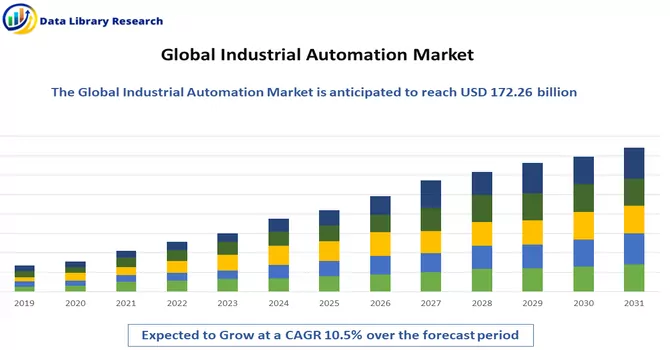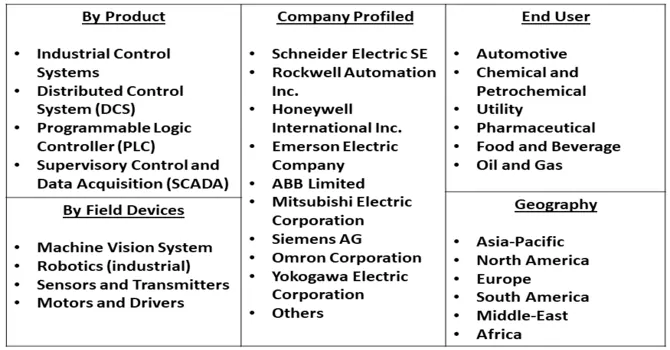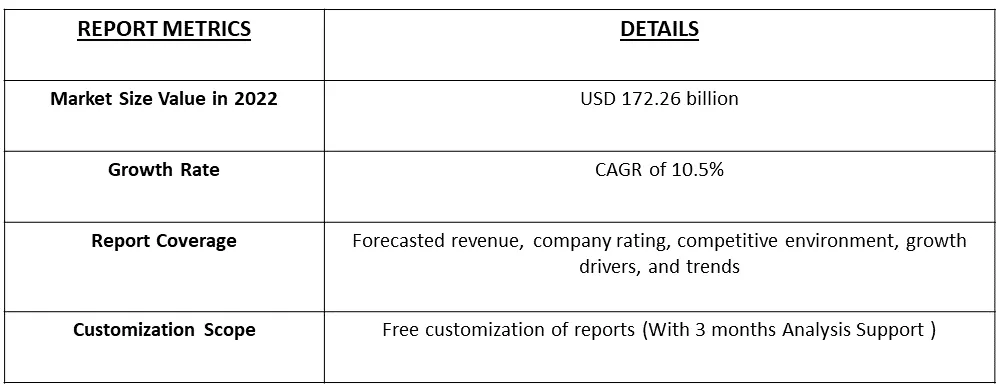The global industrial automation and control systems market size was valued at USD 172.26 billion in 2022 and is anticipated to register a compound annual growth rate (CAGR) of 10.5% from 2023 to 2030.

Get Complete Analysis Of The Report - Download Free Sample PDF
The industrial sector has been evolving rapidly with the continual introduction of sophisticated technologies such as robotics, artificial intelligence, and more. Additionally, automation enables swift operations of manufacturing and material handling with the use of intelligent manufacturing infrastructure.
Industries are deploying industrial automation and control systems in an attempt to increase productivity and reduce labor costs. Moreover, with the advent of Industry 4.0, the manufacturing sector has been experiencing rapid adoption of new systems and augmented networking architectures, which is projected to provide significant opportunities for market growth.
Developments in machine learning, robotics, 5G, edge computing, blockchain, and IIoT will remain to have a major impact on industrial automation. Collaborative robots are the biggest industrial automation trend in 2023 and they are likely to remain the biggest trend throughout the 2020s, particularly when it comes to packaging automation.
Segmentation The report covers Global Industrial Automation Systems Market Share and is segmented
By Product :
By Field Devices :
By End User :

For Detailed Market Segmentation - Download Free Sample PDF
Market Driver:
Emergence of Connected Enterprises and Requirement of Mass Manufacturing of Products
The emergence of the concept of connected enterprises is fueling the growth of the industrial automation market globally. In addition, efficient information flow across different units in industries is an important factor for enhanced production activities to enable manufacturers to understand the process of converting raw materials into finished goods in an improved manner with the help of IoT and IP networks.
Furthermore, technological developments are expected to drive the growth of the studied market. For instance, in July 2022, Rockwell Automation, Inc., the world’s largest company dedicated to industrial automation and digital transformation, announced the launch of the PowerFlex AC variable frequency drive portfolio in the Asia Pacific to support an array of motor control applications. This will provide customers with more flexibility, performance, and intelligence in their next-generation drive through TotalFORCE Technology. Thus, the market is expected to witness significant growth over the forecast period.
Growing Demand for Industrial IoT The Industrial Internet of Things (IIoT) and Industrial 4.0 are at the center of the new technological approaches for the development, production, and management of the entire logistics chain, otherwise known as smart factory automation, and are dominating the trends in the industrial sector, with machinery and devices being connected via internet. Further, brands such as Hyundai have invested heavily in smart mobility solutions to stay ahead of their competitors. With cars becoming smarter and more connected, having a company specializing in robotics and AI can be a great asset in the long run. In June 2021, Hyundai Motor Company confirmed that they had bought a controlling interest in Boston Dynamics from SoftBank. According to the deal, the American robotics developer has been valued at USD 1.1 billion, and Hyundai has 80% shares while SoftBank still owns 20%.
Market Restraints:
Trade Tensions and Implementation Challenges
Complexity and Integration: As automation systems become more advanced, integrating various components and technologies can become complex. Ensuring seamless communication between different devices and systems is a challenge. However, it also comes with some challenges, such as high initial costs, maintenance issues, skills gaps, and ethical concerns. In this article, you will learn some strategies to overcome these challenges and make the most of industrial automation.
The market was disrupted when the COVID-19 epidemic forced the closure of enterprises and manufacturing facilities worldwide. Significant losses were incurred, particularly in the first two quarters of the year, as a result of the drop in demand for industrial automation systems in the manufacturing sectors. Fortunately, there have been encouraging signs of a resurgence in the first few months of 2021, owing to the reopening of the plants and the restart of industrial operations. Industry 4.0 technology advancements have increased demand for automated solutions like robots across a wide range of industrial industries.
Segmental Analysis :
The Industrial Control System Is Expected to Drive the Growth Of The Studied Market.
An industrial control system is an electronic control system and associated instrumentation used for industrial process control. Control systems can range in size from a few modular panel-mounted controllers to large interconnected and interactive distributed control systems with many thousands of field connections. With fewer manual requirements and greater productivity, an ICS helps you boost efficiency. Thus, the segment is expected to witness significant growth over the forecast period.
The Pharmaceutical Automation Segment is Expected to Witness significant Growth Over the Forecast Period.
Pharmacy automation encompasses centralized or decentralized automated dispensing, packing, labeling, and other systems, which help reduce dispensing errors while improving the workflow efficiency of hospital nursing staff and pharmacies. Moreover, there is a growing demand for automated systems that help stock and inventory management. For instance, in March 2022, Capsa Healthcare expanded its suite of NexsysADC automated dispensing cabinets. Nexysys can accommodate any size of controlled and highly valued medications or supplies in two new sizes of controlled access module drawers. Thus, the segment is expected to witness significant growth over the forecast period.
North America by Geographical Segment is Expected to Witness High Growth Over the Forecast Period
The automotive industry will similarly undergo a change fueled by digitization, rising automation, and new business models. Four disruptive technology-driven trends are emerging in the automobile industry as a result of these factors: diversified mobility, autonomous driving, electrification, and connection. However, market participants may face difficulties due to the growing popularity of rental and used car markets. Growing logistics and delivery services, along with the expansion of vehicle fleets by major e-commerce players like Amazon, etc., significantly impact the demand for commercial cars. The adoption of factory automation solutions can help these manufacturers in cost savings, enhance productivity, and improve quality. Recently, the Royal Bank of Canada (RBC) collaborated with Microsoft and launched the Go Digital program to help Canadian businesses invest in smart automation technologies and cloud solutions. The program is available to Canadian food manufacturers and will continue expanding to other industries.
In addition, in North America, orders for robots from automakers and component manufacturers accounted for 47% of all orders in the first quarter of 2022. Several automakers have announced investments better to outfit their plants for future electric drive car models or to boost battery production capacity. These significant initiatives will increase the demand for industrial robots in the coming years.

Get Complete Analysis Of The Report - Download Free Sample PDF
The Global Factory Automation and Industrial Controls Market is highly competitive and consists of several major players. The market appears to be moderately fragmented. The major players with prominent shares in the market are focusing on expanding their customer base across foreign countries. These companies are leveraging strategic collaborative initiatives to increase their market shares and profitability.
The companies operating in the market are also acquiring start-ups working on factory automation and industrial control systems to strengthen their product capabilities. Some of the major players working in this market are-
Key Players :
Recent Development :
1) June 2022 - Mitsubishi Electric Corporation announced that it would invest around INR 2.2 billion in its subsidiary Mitsubishi Electric India Pvt. Ltd. to establish a new factory in India. The company is expected to start factory operations in December 2023, with the factory manufacturing inverters and other factory automation (FA) control system products, expanding the company's capabilities to meet the growing demand in India.
2) May 2022 - DENSO Corporation and Honeywell announced that they are co-developing an electric motor for the Lilium Jet. This is the first product developed by these companies since formalizing their alliance, and it marks DENSO's entry into the aerospace market. Both companies will work with Lilium, the developer of the first all-electric vertical take-off and landing ("eVTOL") jet, to integrate the electric motor into Lilium's aircraft engines.
Q1. What is the market size of the Industrial Automation Market ?
Industrial Automation Market is anticipated to register a compound annual growth rate (CAGR) of 10.5% from 2023 to 2030.
Q2. Which Region is expected to hold the highest Market share?
North America region is expected to hold the highest Market share
Q3. What segments are covered in the Industrial Automation Market Report?
Industrial Automation Market Report covers segments like - By Product, By Field Devices and End User.
Q4. What are the Growth Drivers of the Industrial Automation Market ?
The Industrial Control System Is Expected to Drive the Growth Of The Studied Market
Data Library Research are conducted by industry experts who offer insight on industry structure, market segmentations technology assessment and competitive landscape (CL), and penetration, as well as on emerging trends. Their analysis is based on primary interviews (~ 80%) and secondary research (~ 20%) as well as years of professional expertise in their respective industries. Adding to this, by analysing historical trends and current market positions, our analysts predict where the market will be headed for the next five years. Furthermore, the varying trends of segment & categories geographically presented are also studied and the estimated based on the primary & secondary research.
In this particular report from the supply side Data Library Research has conducted primary surveys (interviews) with the key level executives (VP, CEO’s, Marketing Director, Business Development Manager and SOFT) of the companies that active & prominent as well as the midsized organization
FIGURE 1: DLR RESEARH PROCESS

Extensive primary research was conducted to gain a deeper insight of the market and industry performance. The analysis is based on both primary and secondary research as well as years of professional expertise in the respective industries.
In addition to analysing current and historical trends, our analysts predict where the market is headed over the next five years.
It varies by segment for these categories geographically presented in the list of market tables. Speaking about this particular report we have conducted primary surveys (interviews) with the key level executives (VP, CEO’s, Marketing Director, Business Development Manager and many more) of the major players active in the market.
Secondary ResearchSecondary research was mainly used to collect and identify information useful for the extensive, technical, market-oriented, and Friend’s study of the Global Extra Neutral Alcohol. It was also used to obtain key information about major players, market classification and segmentation according to the industry trends, geographical markets, and developments related to the market and technology perspectives. For this study, analysts have gathered information from various credible sources, such as annual reports, sec filings, journals, white papers, SOFT presentations, and company web sites.
Market Size EstimationBoth, top-down and bottom-up approaches were used to estimate and validate the size of the Global market and to estimate the size of various other dependent submarkets in the overall Extra Neutral Alcohol. The key players in the market were identified through secondary research and their market contributions in the respective geographies were determined through primary and secondary research.
Forecast Model
